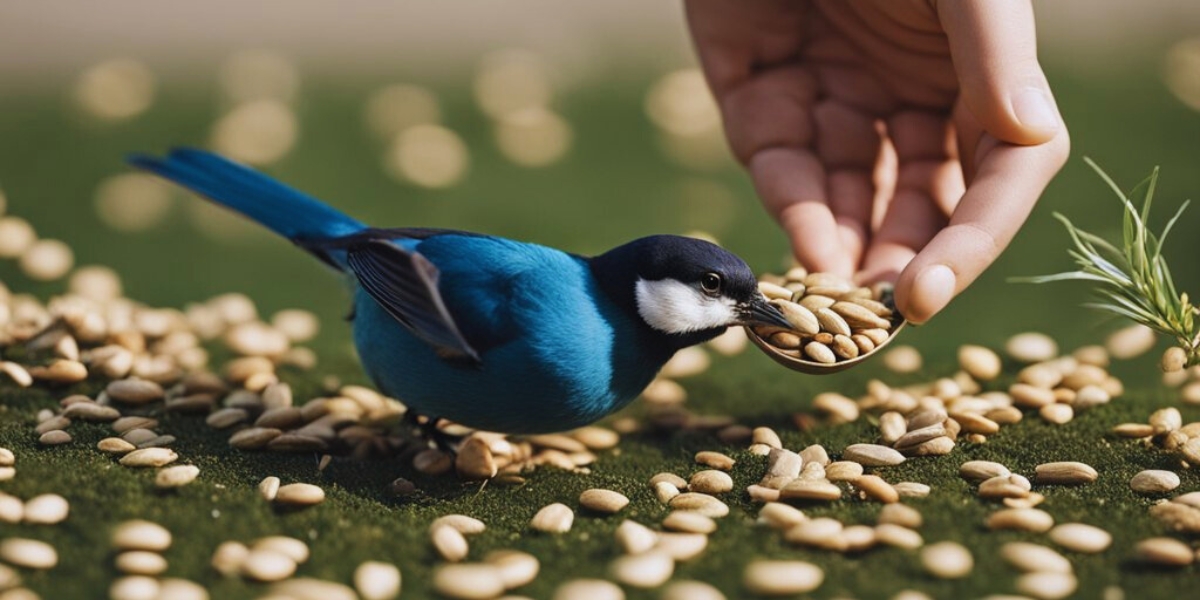Bird feeding brings joy as we watch colorful species visit our yards. But it also means dealing with spilled and scattered seeds below feeders. While birds eat most seeds, accumulations can build up, creating messes and waste. Learning the most effective methods to clean fallen seeds will keep our bird feeding areas tidy for our enjoyment and the health of the birds. In this article, we will explore 10 smart ways to clean up bird seed on the ground. With a combination of proactive prevention and efficient cleaning strategies, we can master seed spill management and keep the seed in the feeders where it belongs.
10 Ways to Clean Up Bird Seed on the Ground
1. Use Seed Catchers Under Feeders
One of the best ways to prevent massive seed buildup is to use catchers and trays under feeders to grab the spillage before it hits the ground. Quality seed catchers attach directly to feeder poles or hang below feeders to create a collecting surface for dropped seeds. They come in trays, pans, mesh bags, and funnel designs. Routinely emptying seed from catchers prevents overflow onto the ground. Tip: Pair catches with feeders designed to minimize spilling in the first place.
2. Rake or Sweep Up Scattered Seeds
For seeds that make it to the ground, raking or sweeping is an easy cleanup method. A stiff bristle broom can corral seeds into piles for pick-up. Opt for a heavy-duty push broom with natural bristles. Make sure to get into corners and under bushes where errant seeds may hide. Raking with a stiff-tie garden rake also works well, especially on rough or uneven terrain. Sweep or rake gently to avoid grinding seeds into the soil.
3. Use a Shop Vacuum
Shop vacuums are powerful helpers for bird seed pickup. Choose a vacuum with a wider nozzle opening to avoid clogs from small seeds. Adjust to lower suction if seeds are getting stuck. Move slowly over the area, liberally vacuuming up piles and spots of hard-to-sweep seeds. Shop vacs excel at sucking seeds from cracks and gravel. Bonus: They pull up any feathers, hulls, or other debris too. Just remember to empty the collection tank frequently to avoid clogs.
4. Try a Leaf Blower for Light Seeds
For smaller, lighter seeds like nyjer and finch mixes, a cordless leaf blower can blast seeds into tidy piles for easy corraling. Ensure blowers have variable speed settings to avoid blowing seeds away too aggressively. Wear protective eyewear. Move steadily, overlapping rows across seed spill areas. Then rake or sweep together the blown piles and discard waste. Just be cautious of blowing seeds into planting beds or lawns where they may sprout unnecessarily.
5. Apply a Seed Scrubbing Brush Attachment
Scrub brush attachments for garden hoses are a back-saving way to scrub up embedded seeds from porous surfaces like brick, concrete, or gravel. The spinning brush dislodges stuck-on seeds, so water spray can rinse them away. Adjust the water pressure to avoid splashing seeds deeper into surface cracks. Thoroughly scrub corners and crevices. When finished, rake or vacuum water runoff to capture liberated seeds for disposal.
6. Use a Pressure Washer for Stubborn Seeds
Pressure washers provide intense cleaning power to remove stubborn seed stains and ground-in debris from outdoor surfaces, like patios and decks. Adjust the pressure lower and test on inconspicuous areas first to avoid damage. Keep the nozzle head 6-12 inches from the cleaning surface for best results. Let the spray do the work, not excessive pressure. Pick up dislodged seeds with a shop vac. Allow surfaces to fully dry before reinstalling feeders nearby to avoid moisture damage.
7. Apply Corn Gluten as an Organic Pre-Emergent
To prevent seeds from taking root and sprouting in the soil, apply corn gluten meal as a natural pre-emergent barrier. The protein in corn gluten inhibits seed germination and root growth when watered into the soil. Reapply every 2-3 months for ongoing prevention. Corn gluten also feeds soil microbes as it breaks down. Just be sure to keep barriers away from the desired planting beds. It’s ideal for open soil under seed feeders.
8. Solarize Soil to Kill Unwanted Seed Growths
In areas prone to heavy seed accumulation, solarizing soil can kill emerging unwanted sprouts. First, wet the area. Then cover loosely with clear plastic sheeting and leave for 1-2 months in warm weather, allowing sun heat to destroy weeds and seedlings under the “greenhouse”. Refresh the plastic occasionally to trap heat. The double hit of heat and suffocation kills germinated seeds. Afterwards, mulch or gravel the area for further protection.
9. Apply Landscape Fabric to Block Seeds
Where feeders overhang beds, secure landscape fabric onto the soil before mulching to barricade seeds from taking root. Use breathable, porous fabric to prevent moisture issues. Fabric lets water seep through but blocks the light needed for seed germination. Pin carefully with landscape staples, leaving a collar around feeder poles for cleaning access. Cut X-shaped holes where the desired plants already exist. Refresh the fabric, as it degrades over time.
10. Mulch Heavily Below Feeders
One of the easiest passive ways to smother seeds is by applying 2-4 inches of organic mulch below feeders and catchers. Natural mulches like shredded bark prevent light from reaching fallen seeds. Their texture also hinders seeds from contacting the soil. Replenish mulch 1-2 times per year as rain compacts it. Or install gravel or pea stone mulch for a permanent decorative solution. Just be sure mulch doesn’t bury or touch feeder bases.
People Also Read:
Conclusion
Preventing and cleaning up messy bird seed spills from feeders takes some strategy and elbow grease. But a combination of proactive feeder placement, containment tools like seed catchers, efficient cleaning methods like vacuums and power washing, and soil barriers using mulch, landscape fabric, or corn gluten can tame the seed chaos. Birds will benefit from less waste underfoot, and we’ll enjoy cleaner yard spaces for birdwatching. With the right techniques, we can easily maintain balance between feeding our feathered friends and keeping seed messes at bay.

